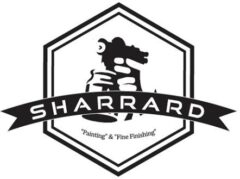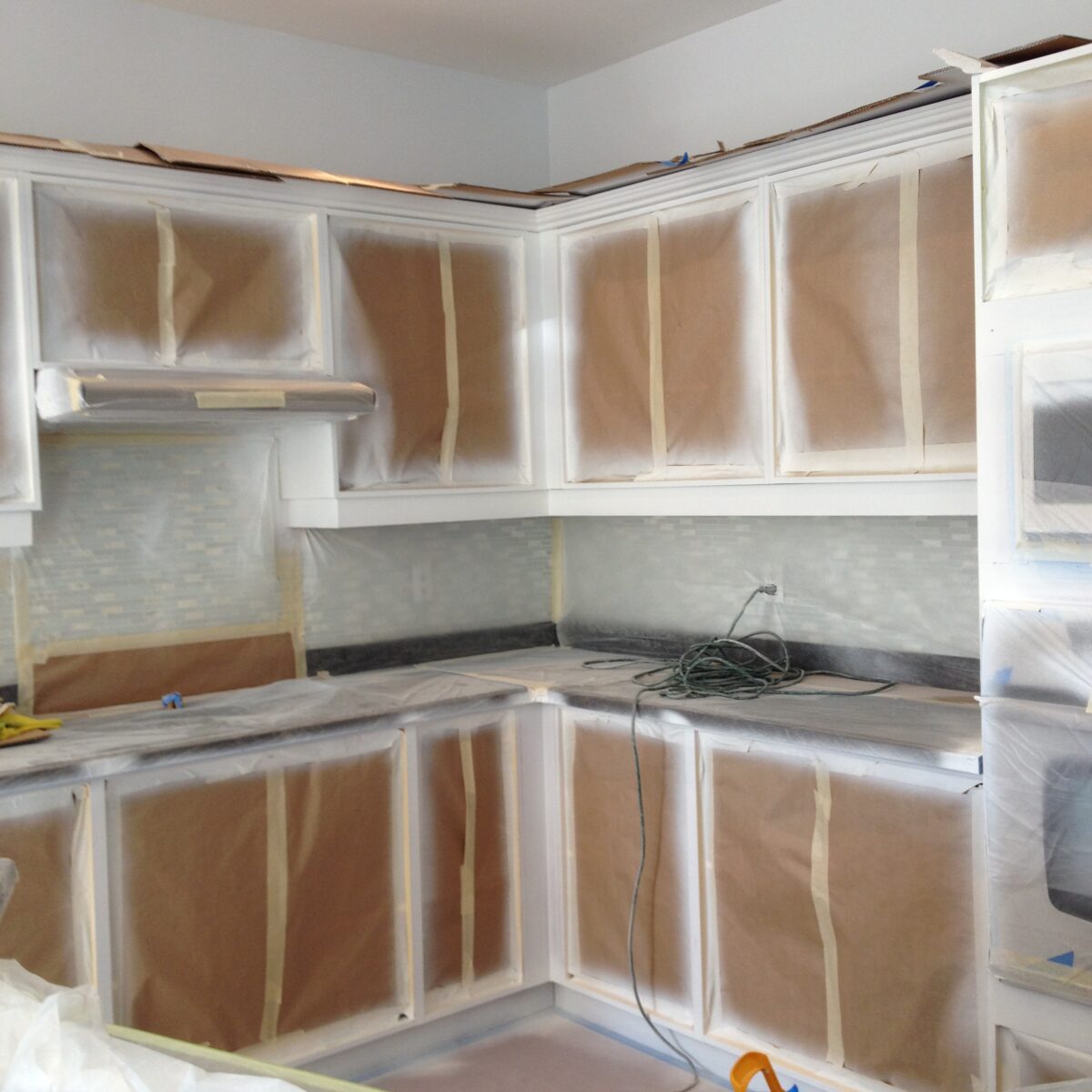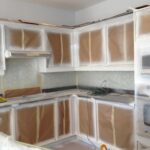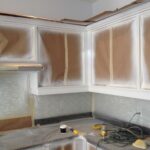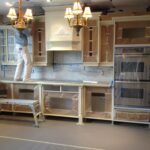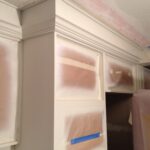By Todd Sharrard. When refinishing kitchen cabinets the painting of base cabinetry refers to the refinishing of articles that cannot be removed and painted off site. In your standard kitchen this includes things such as the kick plates, gable ends, valance and crown mouldings; it can also refer to the painting of the stile and rail edge banding that surrounds each cabinet carcass.
This is our refined process for spray painting the on-site portion of any kitchen cabinet refinishing project – your typical 30 to 45 piece kitchen will take two people about two days to go through this entire process (the on-site work only). It is labour intensive, yes very much but, the goal is to make the kitchen look not painted, but in fact, constructed in the colour of choice. The gable end, crowns, and valances may end up being the most visible elements of your kitchen cabinetry so they should be spray painted, just like the cabinet doors and drawers.
Terminology:
- cabinet carcass is the cabinet box or shell without its cabinet doors or drawers.
- the term rail is used to refer to the horizontal edge of a carcass or cabinet door
- stile is the vertical edge of the carcass or cabinet door
- carcasses can be frameless typically with European style hinges or have a face frame attached with overlay hinges.
Factors that Impact Site work
- site work in condos is hard, ventilation can be an issue especially since the kitchen is not equipped with windows
- large open concept kitchens can also be a challenge to tape off and contain dust.
- oversite cleanliness of the site and other work being done at the same time.
- cabinet contents – it’s an easier and therefore better job done if the kitchen has been completely emptied
Tools & Sundry List:
Beyond your standard painting tools and accessories, these are the critical items I need for finishing base cabinets in your typical 45 piece kitchen.
- 3 stage or greater HVLP turbine sprayer or portable compressor-based sprayer
- Good quality rosin paper or flooring paper
- Dnya Patch Pro (best for lacquer) – Dulux, Home Depot
- 3m Easy Masker
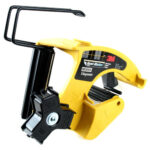
Hand Masker – toys for big boys, not essitenal for the DIYer, that aside, I can’t believe i used to work without one. - Good quality 1.5 inch masking tape. 3M blue tape is good for a DIY job.
- Paper Rolls or Plastic Rolls – 12 inch (used with 3M Easy Masker)
- 24-inch plastic painters flim
- Sharp Knife
- 400 / 320 / 240 Grit & 120 Grit * three stages of sanding and somewhere in that range but nothing less than 320 for the last coat
- red and grey finishing pads * these are optional but sure do help with sanding details and washing
Spray painting base cabinetry can be tricky, in fact, its harder and more time-consuming than painting the actual doors and drawers. The nature of the task is difficult since the base cabinets have many intersecting points, corners and edges and most painting equipment wasn’t made to paint a 1/2 inch strip. All this translates into the perfect setting for a lot paint sags and the occasional holiday (missing a spot).
Step by Step Process:
tape out the floor first – before you move all of your gear into place.
- ensure the floor is free of debris and the perimeter is dust free
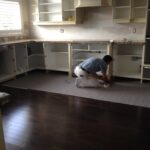
- tape the perimeter of the kick plates with blue tape first
- cover the entire floor with red rosin paper or good quality construction paper. We use a product called Anchor Paper – you can get it a Speers Paint (275 Speers Rd, Oakville), also stocked by Dulux Paints also on Speers Rd.
- use masking tape to secure the paper to floor and to the existing blue tape you applied to the kick plate perimeter. On hardwood floors try to minimize the amount of tape being applied directly to the floor – floors that have been finished onsite vs engineered hardwood are the trickest, make sure your using the right tape.
- determine how appliances will be dealt with – typically the inner fridge gables will need to be painted. Come up with plan on how to deal with dishwasher, stove and fridge during painting process. Does the stove need to be removed in order to paint the cabinet side panels? If the dishwasher is painted in place how will the side panels look when the dishwasher door is open.
wash, sand, fill holes and cracks and clean the base cabinetry
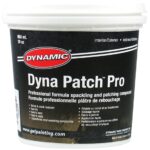
- same as washing cabinetry doors use TSP or a degreaser solution and don’t look upon the task lightly; remember this is a kitchen so it will be dirty and the surfaces will contain substances that will impact the adhesion of paint if not dealt with now.
- Using abrasive pads to clean is ok because your are only going to repaint the surface so wet sanding and washing at the same time works, ie using a wet sanding sponge to get the edge banding clean.
- after washing, if not already scuffed then lightly sand the veneer gable ends and larger flat panels with 150 to 240 grit paper. Don’t over sand the surface, it is either a veneer or an already sealed piece of wood. Try to evenly dull the gloss across the surface, insuring the primer has a good surface to attach to.
- fill holes and cracks that will become very evident if painting the kitchen white or off white. You will do another round of crack filling and hole filling after the application of the primer.
- only use DAP or caulking when wood filler will not work. Always use a spackle or wood filler (such as Dyna patch pro) when possible because they are sandable and will create a smoother finish. Caulking is not sandable. Latex caulking is good to use on top of lacquer but not below it and therefore should only be applied after you have sprayed. One place i like to use latex caulking is in corners where cabinet facing and drywall meet. I apply the latex caulking right before i pull back the tape for a nice clean edge.
- often lines in the countertops are sealed with clear silicone. Silicon may be used to conceal the gap between a countertop and a gable end. Paints and Lacquers will not stick to silicon so it has to be removed/cut out / and sanded smooth. Make sure you do this now and not after priming or the first coat. It’s hard to do, a scraper and a sharp knife are about the only things that will work – I do not know of any product that breaks down silicon. Please contact me if you do.
- Keep in mind that dust on top of the wall cabinets and in the carcasses may get in your way during the painting and taping process. If your upper cabinets are staggered in height the tops of the wall carcasses must be cleaned or else the dust will become airborne when spraying (and land in your wet paint).
tape out the carcasses
- if using a darker colour the inner corners of the carcass must be detailed closely – use 8 pieces of tape to detail out the inner corners of the carcass <need picture>. if there is a lot of contrast between the new color of the kitchen and the inside colour of the cabinets then extra special attention must be paid to taping up the corners.
- the fan width of the sprayer can be adjusted, if the carcass is empty only the perimeter of the stile and rail needs to be taped with paper, if the carcass are full the entire front must be covered with paper.
- when applying paper to the carcass – measure the paper 1/4 of an inch shorter than the height of the carcass. This is where the 3M hand masker comes in handy, more so as dispenser of paper and tape than an actual tool used to apply the paper and tape.
tape out the ceiling and gable ends
- if crown mouldings are being painted using cardboard boxes over the edges sometimes helps with over spray
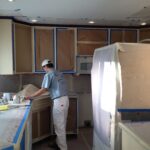
- tape out the gable ends and behind the fridge as required use 24 inch tape and drap. Although the tape and drap will cling to the wall always make sure the tape and drape is secured to the wall at both ends ~ if not the air vacuum created by the paint sprayer will most certainly cause the tape and drape to flap during the spray process, chances are the tape and drape will flap into your wet paint.
tape out appliances
- remove the screws that hold the dishwasher in place and pull out the dishwasher about 6 inches
- tape around the perimeter of the dishwasher and tuck the tape and paper under the counters edge, don’t forget to tape off the dishwashers toe plate
- tape out the range hood and microwave
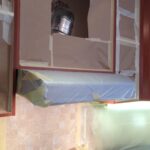
- cover the fridge and stove
tape out counters and the back splash
- lastly remove everything from the counters and cover the counter and back splash with tape and drap
- extra special attention to space under the counter – this should be taped off as well. Your goal should be to not have any unsightly over spray under the counter, this would look very unprofessional and would be visible if you were sitting on the floor.
- use a plastic bags to cover the kitchen sing faucet and protect it from over spray
secure the kitchen
- finally use 9 foot of or 12 foot painters plastic to tape off the entry points to the kitchen; this prevents overspray and spray dust from traveling through the entire house
- use blue tape to attach the painters plastic to the wall and seal the entire perimeter or the opening with tape (not just every 12 inches or so – the floor, top, side, side)
- hopefully, you can place a box fan or a squirrel fan next to a window in the kitchen, use the fan to suck air out of the kitchen and through the window (not in).
- this should create a vacuum of air in the kitchen and the painters plastic should start to draw in , to balance the vacuum you can open the front door and can cut holes in the painters plastic that you used to secure the entry points to the kitchen ~ with the squirrel fan running this will create great wind tunnel that will suck air in through the front door and out the kitchen window.
- experiment with options but do this before the sprayer is running.
- i really don’t like it if people open windows and doors when i start spraying since this will disrupt the flow of air through the house, you might want to instruct the occupants of the house that this is the case ~ seems trivial but trust me when you start to spray the windows upstairs suddenly get opened and people start leaving the house.
prime coat number one
- spray out the primer using a systematic approach
- having someone hold a spotlight and managing the sprayer hose (preventing if from rubbing against previously painted surfaces) will help you greatly.
- multiple coats of primer should be used (min two) – primer is easier to apply and sand than finish paint
- never use a white primer when applying darker colours, consult your paint store and use a primer that is tinted somewhat to the darker colour you are using. The darker primer will not only save you (many) extra coats of the finish paint it will also help to insure the overall longevity and durability of the project by concealing any possible chips or dents that may surface years down the road.
after prime coat number one
- the application of the white primer will reveal all – things such as corners, cracks between the carcass and where the carcass is attached to the gable ends will be very visible now
- review the entire job and refill cracks with spackle or wood filler and only use caulking as required (corners)
- inspect the edge banding, cracks on the sides can be very easy filled with spackle (dyna patch pro)
- inspect the toe plate – holes form the nails will now be very visible if priming in white
- important: at this stage you need to be a very detailed about filling holes and cracks if you want the job to be done right with the least amount of re-coats
- sand out the primer coats using 240 / 220 grit resin bond sand paper and only after you have filled all the holes and cracks.
second prime coat
- apply a second coat of primer, lightly sand after the second prime coat using 220/240, with special attention to gable ends
- be very detailed and systematic in your approach to prime sanding – anything missed at this point will result in a rough or peppered finsih.
first coat
- use a systematic approach to getting everything done, work in the same direction (clockwise, counter-clockwise)
- it possible leave the toe plates until last
- after first coat nib sand all gable ends and larger flat pieces. use 400 grit resin bond paper
second coat & third coat
- basically a repeat of the first coat – not much changes. Since its your final coat keep your eyes on the finish and make sure your overlapping your stroke 50 percent.
- consider a third safely coat since the time required to spray on the coat is so minimal vs the effort extended getting to this point (all the prep work).
clean up
- remove the tape and paper in due time. Take extra special care when lifting the tape up from painted surfaces (eg the wall) – you do not want to lift off the previous paint job.
L6K 2G4, CA
Phone: (905) 334-3242
Website: www.sharrardpainting.ca
